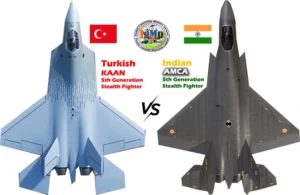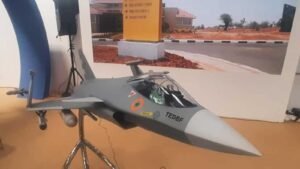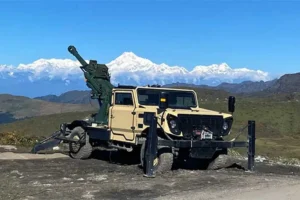Source : The Guardian

Collapsing buildings, incoming missiles : Taiwan rehearses a Chinese assault on its cities
On a Thursday afternoon in Taipei, it was 26 August 2025 and China’s military had just fired a missile into the city, hitting an apartment block. Chinese navy ships had massed in the Taiwan Strait and war was expected. It was all hands on deck.
Rescue squads and paramedics raced around blocked off sites in the city’s business district. Cherrypickers and cranes plucked rookie firefighters – dressed as injured civilians – from the rooftop of a fake demolished building and half-crushed buses.
The first responders hailed from the Red Cross, volunteer defence groups, reservists and nursing students. They did not include enlisted soldiers, who, in the event of an attack, would be busy fighting elsewhere.
Taiwan’s government regularly stages emergency and military drills; from testing the air raid and earthquake alarms to massive live fire drills. But for the first time this year, the civil response drills have included a simulated military strike, prompted by worsening cross-strait tensions, and the war in Ukraine.
“Since the war in Ukraine we have seen the international and regional situation change, so we have to make related preparations,” said Taipei mayor Chiang Wan-an.
“We want peace, and everyone has to realise the importance of peace during this drill, but we are not backing down from a fight and are making all necessary preparations.”
The drills, which are being held weekly across Taiwan’s major cities in May and June, are a sign that the Taiwan authorities realise they need to improve civil defence readiness, as the threat from China grows.
Beijing claims Taiwan as a province of China, and intends to annex it. It wants to resolve this peacefully through Taiwan’s surrender but hasn’t ruled out using force, which would require a full-scale invasion and urban warfare.
Defending Taiwan’s critical infrastructure
Taiwan’s cities are home to 80% of the island’s population and the government has started to step up its defence of urban areas.
Around Taipei there are new air raid shelter signs, and a growing number of apps with instructions, maps, and new methods of reaching emergency services.
But experts say there are still gaps in preparation, particularly around vulnerable points in critical infrastructure, like electricity, internet and water supply, and in how the government communicates to the public.

According to US intelligence, China’s People’s Liberation Army (PLA) has been told to reach capability of invading Taiwan by 2027. The most alarming demonstration of capabilities came in August 2022, when the PLA surrounded Taiwan’s main island with days of live-fire exercises and blockade-style tactics.
A blockade of Taiwan, which could cripple cities, cut off global trade, communication, utilities and other essential supplies, is also now being war gamed. A recent analysis by the CSIS warned the island would not be able to receive aid like Ukraine.
Desktop drills, where responders talk through the response rather than simulate it, have run through attacks on critical communication, utilities and other infrastructure. City food stores and water supplies were analysed, while government documents revealed they also looked at scenarios which mirrored some attacks detected during the drills last August, when government websites were attacked and electronic signage at train stations and convenience stores were hacked.
Taiwan’s electricity supply is hugely vulnerable to a blockade; it drew about 97% of its energy supply in 2021 from imported fossil fuels. After the August drills, the state-owned Taipower and CPC petroleum and natural gas corporation were both told to stockpile reserves and strengthen defensive and response protocols, for periods ranging from 10 to 60 days.
Taipower can quickly respond to isolated faults and outages, but the grid itself is under strain and Taiwan’s cities experience frequent blackouts in the summer. Rooftop solar in urban areas is rare.

“It is imperative that energy resilience, which includes securing ample generator supplies, is a nationwide effort,” said Marcin Jerzewski, a research fellow at thinktank NextGen Taiwan.
Taiwan’s internet is also critically vulnerable, according to TH Schee, of Open Knowledge Taiwan, a non-profit information sharing group.
Unlike Ukraine, where networks in neighbouring countries could be accessed when local services went down, Taiwan has just its own single service, the former government-owned Chunghwa Telecom. Undersea internet cables to the outer islands of Matsu have been repeatedly cut, ostensibly by accident. Taiwan’s digital minister Audrey Tang has said they are fast-tracking plans for a satellite network after seeing how beneficial Starlink has been to Ukraine.
‘Civilians need training’
Beijing has maintained its claim over Taiwan for decades, and until recently most Taiwan residents would respond to questions about the threat of invasion with words of defiance or dismissal.
But after the PLA’s August drills, and then a second round in April, it has become front of mind, particularly with a presidential election less than a year away.
Some in Taipei are attending talks on disaster and conflict preparedness by Tobie, a South African who has lived in Taiwan for 25 years and who has written a book on the topic.
He said Taiwan was “pretty damn good when it comes to people stepping up after a disaster”, but there needed to be more focus on personal preparation. In the event of an attack on Taipei, millions would probably want to flee. But roads out of the city, which is surrounded by a river and mountain ranges, already experience severe gridlock just on weekends.
“It’s going to be a fucking nightmare. I have alternative routes, and hope to do it early,” he says.

Schee is worried that experienced groups like Red Cross Taiwan and Taiwan’s neighbourhood networks of (mostly older) volunteers, which are experienced in responding to local natural disasters like landslides and floods, aren’t getting enough interest from young people who are looking for ways to be involved with the defence of Taiwan.
Instead, city-dwellers are flocking to emerging grassroots and community groups. These range from amateur workouts in city parks to firearms training, first aid courses, and plans for billionaire-funded marksmen militias. It’s enthusiastic but uncoordinated.
“Taipei and New Taipei are home to nearly 30% of Taiwan’s population, but local governments have been slow to prioritise civilian crisis preparedness with a sense of urgency that reflects the threats we face,” said Enoch Wu, a former legislator and founder of Forward Alliance, one of the more established civilian training organisations.
“In a country with only fifteen thousand firefighters and paramedics – that’s one first responder for every 1,500 citizens – civilians need the training and organisation to help their own communities in times of need.”
At the end of Thursday’s event, hundreds of participants were tired and sweaty, but jovial. The emergency vehicles, drones, cameras and dignitaries disappeared, and the rookies were removing the fake blood and injuries from their limbs. There had been fears that the day would be seen as more performative than useful, but participants told the Guardian that it followed three days of rehearsals during which problems were identified and worked on.
In the event of a disaster, or an invasion, these separate teams will have to work together under extreme pressure and potential chaos.
“There were some difficulties in communication [with the other services], but today it was more coordinated,” said Hong En, a 27-year-old firefighter.
Liu Kuei-yo, sub-division chief of a city district fire department said his team was experienced at search and rescue but now had to be ready for “a missile attack at any time”.
“At this moment we’re not completely ready … for war. But we’ll get there.” Taiwan rehearses a Chinese assault on its cities Taiwan rehearses a Chinese assault on its cities Taiwan rehearses a Chinese assault on its cities Taiwan rehearses a Chinese assault on its cities Taiwan rehearses a Chinese assault on its cities Taiwan rehearses a Chinese assault on its cities Taiwan rehearses a Chinese assault on its cities Taiwan rehearses a Chinese assault on its cities Taiwan rehearses a Chinese assault on its cities Taiwan rehearses a Chinese assault on its cities Taiwan rehearses a Chinese assault on its cities Taiwan rehearses a Chinese assault on its cities Taiwan rehearses a Chinese assault on its cities Taiwan rehearses a Chinese assault on its cities IgMp








